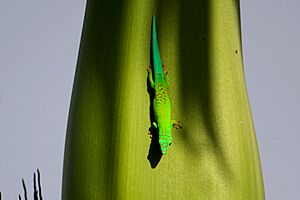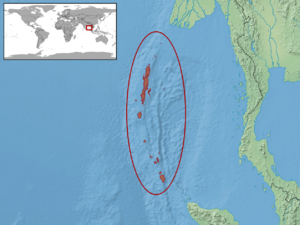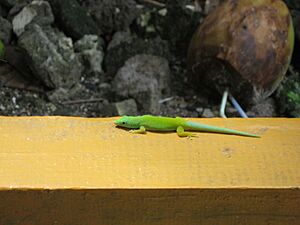Andaman day gecko facts for kids
Quick facts for kids Andaman day gecko |
|
|---|---|
 |
|
| Conservation status | |
| Scientific classification | |
| Genus: |
Phelsuma
|
| Species: |
andamanensis
|
 |
|
| Synonyms | |
|
|
The Andaman day gecko (Phelsuma andamanensis) is a special type of gecko. It's also known as the Andaman Islands day gecko. This small, thin lizard is bright green with red spots. It lives only on the Andaman Islands in India. Recently, it has also been found on the Nicobar Islands. This gecko eats insects. Its home is very far, almost 5,000 kilometers, from where most other Phelsuma geckos live, which is near Mauritius and Madagascar.
Contents
Where Does This Gecko Fit In?
Scientists believe the Andaman day gecko is the oldest living member of the Phelsuma gecko family. It separated from the other Phelsuma geckos about 27 million years ago. This happened during a time called the late Oligocene period.
There's a lot of different genetic information, like mitochondrial "fingerprints," found in these geckos. This shows they arrived in the Andamans naturally. Humans did not bring them from other islands.
Even though these geckos have lived and changed on the Andamans for millions of years, they haven't formed many new species. However, they can be grouped into two main populations. There's a 'North' group and a 'South' group. These two groups likely separated before the last big ice age. We don't know why they split up.
Where Do Andaman Day Geckos Live?
The Andaman day gecko lives all over the Andaman Islands in India. The 'North' group is found on North Andaman, Middle Andaman, Interview, Baratang, Shaheed Dweep, and Long Islands.
The 'South' group lives on Swaraj Dweep, South Andaman, and Little Andaman Islands. While they reached the Andaman Islands naturally, humans might have helped them spread to some parts of the islands. This is because they can live in many different places. They have also been seen on the Nicobar Islands recently. This is probably because humans moved them there.
What Does the Andaman Day Gecko Look Like?
This day gecko has a bright green body. It has red dots and stripes on its back. Male geckos have a bluish or turquoise colored tail. A reddish-brown stripe runs from their nose to their ear on both sides of their face. The underside of their body is bright yellow or off-white.
Where Do They Hang Out?
Andaman day geckos live in low-lying areas. You can often find them in home gardens. They like to live on coconut palms, screw pines, banana trees, and sisal plants. Sometimes, they even live on local huts.
Because they can live in many different places, their numbers have grown a lot. This happened as more cash crops were planted on the Andamans. It's rare for an island animal to benefit so much from human changes. However, having so many geckos in one place might make them more likely to get sick.
How Do They Behave?
These day geckos are usually shy. But they can be very aggressive towards other geckos of their own kind.
How Do They Have Babies?
The Andaman day gecko usually lays two eggs. They place their eggs in a safe, high-up spot. Female geckos can lay many eggs. One female was seen laying 14 pairs of eggs over 18 months.
See Also
- Phelsuma



